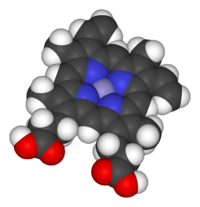
Photo from wikipedia
Because of the instability and Fenton reactivity of non-precious metal nitrogen-carbon based catalyst when processing the oxygen reduction reaction (ORR), seeking for electrocatalysts with highly efficient performance becomes very highly… Click to show full abstract
Because of the instability and Fenton reactivity of non-precious metal nitrogen-carbon based catalyst when processing the oxygen reduction reaction (ORR), seeking for electrocatalysts with highly efficient performance becomes very highly desired to speed up the commercialization of fuel cell. Herein, chromium (Cr)-N4 electrocatalyst containing extraterrestrial S formed axial S1 -Cr1 N4 bonds (S1 Cr1 N4 C) is achieved via an assembly polymerization and confined pyrolysis strategy. Benefiting from the adjusting coordination configuration and electronic structure of the metal center through axial coordination, S1 Cr1 N4 C exhibits enhanced the intrinsic activity (half-wave potential (E1/2 ) is 0.90 V versus reversable hydrogen electrode, RHE) compared with that of CrN4 C and Pt/C catalysts. More notably, the catalyst is almost inert in catalyzing the Fenton reaction, and thus shows the high stability. Density functional theory (DFT) results further reveal that the existence of axial S atoms in S1 Cr1 N4 C moiety has the better ORR activity than Cr1 N4 C moieties. The axial S ligand in S1 Cr1 N4 C moiety can break the electron localization around the planar Cr1 N4 active center, which facilitated the rate-limiting reductive release of OH* and accelerated overall ORR process. The present work opens up a new avenue to modulate the axial ligand type of the single-atoms (SAs) active center to enhance intrinsic SAs performances.
Journal Title: Small
Year Published: 2023
Link to full text (if available)
Share on Social Media: Sign Up to like & get
recommendations!